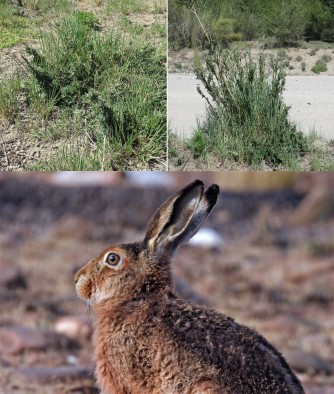
Browsing by alien vertebrate herbivores can have both positive and negative impacts on plant invasion. We studied the European hare (Lepus europaeus) diet and foraging behavior focusing on interactions with two invasive non-native shrub species, Cytisus scoparius and Rosa rubiginosa. Fecal pellets were used for microhistological analysis of diet and seed identification. Foraging use of both species was evaluated by browsing rankings. The diet consisted of 28 items, predominating native grasses such as Poa spp. and Festuca pallescens. Among the non-native species, the grasses Hordeum spp. leaves and stems of the shrub C. scoparius, and seed fragments of Rumex acetosella, and rosehip stand out. Fecal pellets contained 431 whole seeds from nine plant species, predominating non-native species. In diet analysis, a portion of damaged rosehip seeds was observed; however, a significant number of viable seeds were previously extracted. This suggests that consumption of R. rubiginosa fruits contributes to seed dispersal, facilitating its spread. In contrast, the browsing of L. europaeus on the vegetative parts of C. scoparius juveniles significantly reduced their cover, which could slow their growth or prevent their spread. These results are an important input for management decisions to prevent or delay the spread of these invasive species.